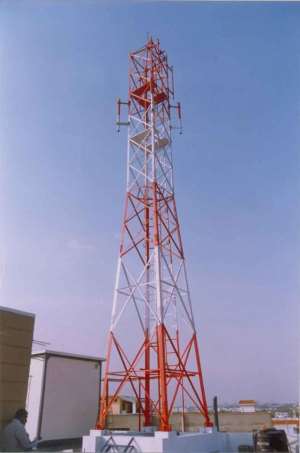
Accra, July 6, GNA – Professor Emmanuel Amamoo-Otchere, Chief Executive Officer of Development Geo-Information Service (DeGEOSERV), on Monday said even though there was no scientific certainty, as yet, about the health impact of radio waves from telecom masts there was need for precaution in the spread of telecom masts across country.
“If, indeed, radio waves from telecom masts could cause some health hazards, it will be proven scientifically with time, but until then it is important to heed the advice of the World Health Organisation (WHO) and take precautionary measures in spreading telecom masts across the country,” he said.
Prof. Amamoo-Otchere said co-location was an alternative, provided the operators would agree not to outdo each other, adding that when fibre optics became the order of the day, it would also reduce the industry's dependence on satellite technology and thereby naturally rule out the use of telecom masts.
Official information available on the WHO website, based on research carried out in other jurisdictions, indicated that radio waves from telecom masts could cause alterations in sleep and blood flow without necessarily causing any health problems.
In addition, it said radiation from Universal Mobile Telecommunications Systems (UMTS) signals, rather than GSM signals, could have low-amplitude effects on the general well being in humans. UMTS based stations are used to run third generation (3G, 3.5G) technology.
Prof. Amamoo-Otchere however noted that the claim that emission from telecom masts was more harmful to people who reside closely to telecom antenas, was, at this stage, a misconception, since it had not been proven scientifically.
He explained that radiation from the telecom masts were non-ionizing, which 'do not disrupt the molecular structure of biological materials', and that radiations from telecom masts in Ghana were within the levels prescribed by the independent International Commission on Non-Ionizing Radiation Protection (ICNIRP), which was far lower than what could be harmful to the human body.
Prof. Amamoo-Otchere, who had said elsewhere that the high density of telecom mast was necessary to ensure network quality, said the intensity of radiation from telecom mast reduced drastically as it travelled away from the antenna and even would reduce further going through buildings and trees.
“Besides, all established health effects of exposure to radio frequencies from mobile communications were related to heating.
“The level of heating that will occur from exposure to radio waves within the exposure guidelines is extremely low, and the body's normal thermoregulatory processes effectively dissipate any heat away that might be generated,” he said.
Prof. Amamoo-Otchere however called on telecom operators in the country to show respect and greater social commitment to the residents of the communities in which they had erected their masts.
He said the argument about the possible health impact of radiation from telecom masts should be taken to the doorstep of the operators with the view to ensuring that they showed respect to the public, when mounting masts, and also providing greater social safety nets for the people.
He noted that the public's seeming antagonistic attitude towards telecom masts was largely due to the usual inadequate engagement between the operators and the public when masts were being erected.
Prof. Amamoo-Otchere said the telecom operators had been showing affluence and flamboyance in many ways that did not directly benefit the residents of communities housing telecom masts, causing displeasure to the people.
He noted, for instance, that in a country where the National Health Insurance Scheme (NHIS) had a limited cover, the affluent telecom companies could go beyond making sporadic commitments to the health sector and make commitments that would cushion the NHIS on a sustainable basis.
“After all, the greatest public concern about the telecom masts is the perceived health hazards,” he said.
GNA




 Akufo-Addo commissions Phase II of Kaleo solar power plant
Akufo-Addo commissions Phase II of Kaleo solar power plant
 NDC panics over Bawumia’s visit to Pope Francis
NDC panics over Bawumia’s visit to Pope Francis
 EC blasts Mahama over “false” claims on recruitment of Returning Officers
EC blasts Mahama over “false” claims on recruitment of Returning Officers
 Lands Minister gives ultimatum to Future Global Resources to revamp Prestea/Bogo...
Lands Minister gives ultimatum to Future Global Resources to revamp Prestea/Bogo...
 Wa Naa appeals to Akufo-Addo to audit state lands in Wa
Wa Naa appeals to Akufo-Addo to audit state lands in Wa
 Prof Opoku-Agyemang misunderstood Bawumia’s ‘driver mate’ analogy – Miracles Abo...
Prof Opoku-Agyemang misunderstood Bawumia’s ‘driver mate’ analogy – Miracles Abo...
 EU confident Ghana will not sign Anti-LGBTQI Bill
EU confident Ghana will not sign Anti-LGBTQI Bill
 Suspend implementation of Planting for Food and Jobs for 2024 - Stakeholders
Suspend implementation of Planting for Food and Jobs for 2024 - Stakeholders
 Tema West Municipal Assembly gets Ghana's First Female Aircraft Marshaller as ne...
Tema West Municipal Assembly gets Ghana's First Female Aircraft Marshaller as ne...
 Dumsor is affecting us double, release timetable – Disability Federation to ECG
Dumsor is affecting us double, release timetable – Disability Federation to ECG
